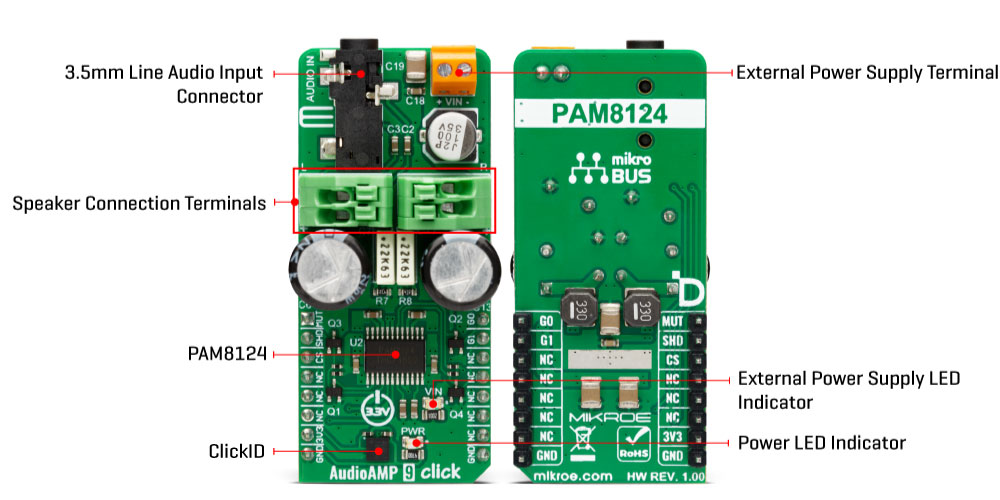OFF
GO LOCAL
| Company | Stock | Price |
|---|---|---|

MIKROE-5595
27 g
Status:
AudioAMP 9 Click is a compact add-on board reproducing input audio signals with desired volume and power levels at sound-producing output elements. This board features the PAM8124, a 10W efficient, Class-D audio power amplifier from Diodes Incorporated for driving stereo speakers in a single-ended configuration. This GPIO configurable audio amplifier can drive 8Ω stereo speakers and provides configurable features such as Mute, Shutdown, and selectable gain of the amplifier. It supports external supply voltage from 12V to 24V, allowing it to be used in many applications. Besides, it is equipped with protection features, allowing a reliable operation. This Click board™ is suited for various types of consumer audio equipment applications.
AudioAMP 9 Click is fully compatible with the mikroBUS™ socket and can be used on any host system supporting the mikroBUS™ standard. It comes with the mikroSDK open-source libraries, offering unparalleled flexibility for evaluation and customization. What sets this Click board™ apart is the groundbreaking ClickID feature, enabling your host system to seamlessly and automatically detect and identify this add-on board.
This product is no longer in stock
Availability date:
OFF
| Company | Stock | Price |
|---|---|---|

AudioAMP 9 Click is based on the PAM8124, a stereo class-D audio power amplifier from Diodes Incorporated. Besides an excellent quantity performance, such as high efficiency, the PAM8124 is also characterized by high output power, low quiescent current, and eliminates the need for heat sinks. It can drive 8Ω stereo speakers in a single-ended configuration with 10W of output power per channel from the externally brought supply voltage. Furthermore, the PAM8124 has several protection features like thermal overload, short circuit, and over/under-voltage protection allowing a reliable operation.

This GPIO configurable audio amplifier provides configurable features such as Mute, Shutdown, and selectable gain of the amplifier. The gain of the amplifier is controlled by two selectable gain pins, G1 and G2 pins of the mikroBUS™ socket, offering 20dB, 26dB, 32dB, and 36dB gain selections. The MUT pin of the mikroBUS™ socket controls the output state of the PAM8124 (quick disable or enable of the outputs). A logic low state on this pin causes the outputs to run at a constant 50% duty cycle. A logic high state on this pin enables the outputs.
The PAM8124 also employs a Shutdown operation mode to reduce supply current to the absolute minimum level during periods of non-use to save power. The SHD pin should be pulled low during normal operation when the amplifier is in use. Pulling the SHD pin high causes the outputs to mute and the amplifier to enter a low-current state. The amplifier should be set in Shutdown mode for the best power-off pop performance before removing the power supply voltage. For the best start-up pop performance, the amplifier should be put in Mute mode before restarting the amplifier.
This Click board™ supports an external power supply for the amplifier, which can be connected to the input terminal labeled as VIN and should be within the range of 12V to 24V, while the input audio can be brought to the input jack labeled as AUDIO IN and after specific processing reproduced on the speakers of the desired L/R channel. In addition, this board has an additional red LED indicator marked with VIN, which can visually detect the presence of an external power supply.
This Click board™ can only be operated with a 3.3V logic voltage level. The board must perform appropriate logic voltage level conversion before using MCUs with different logic levels. However, the Click board™ comes equipped with a library containing functions and an example code that can be used as a reference for further development.
Type
Amplifier
Applications
Can be used for various types of consumer audio equipment applications
On-board modules
PAM8124 - stereo class-D audio power amplifier from Diodes Incorporated
Key Features
10W per channel from 24V external supply, single-ended configuration, high efficiency, GPIO configurable, can drive 8Ω stereo speakers, configurable features such as Mute, Shutdown, and selectable gain of the amplifier, protection features, and more
Interface
GPIO
Feature
ClickID
Compatibility
mikroBUS™
Click board size
L (57.15 x 25.4 mm)
Input Voltage
3.3V
This table shows how the pinout on AudioAMP 9 Click corresponds to the pinout on the mikroBUS™ socket (the latter shown in the two middle columns).
| Label | Name | Default | Description |
|---|---|---|---|
| LD1 | PWR | - | Power LED Indicator |
| LD2 | VIN | - | External Power Supply LED Indicator |
| Description | Min | Typ | Max | Unit |
|---|---|---|---|---|
| Supply Voltage | - | 3.3 | - | V |
| External Power Supply | 12 | - | 24 | V |
| Output Power | - | - | 10 | W |
| Load Impedance | - | 8 | - | Ω |
We provide a library for the AudioAMP 9 Click as well as a demo application (example), developed using Mikroe compilers. The demo can run on all the main Mikroe development boards.
Package can be downloaded/installed directly from NECTO Studio Package Manager (recommended), downloaded from our LibStock™ or found on Mikroe github account.
Library Description
This library contains API for AudioAMP 9 Click driver.
Key functions
audioamp9_shutdown_on AudioAmp 9 shutdown on function.
audioamp9_mute_off AudioAmp 9 mute off function.
audioamp9_set_gain_level AudioAmp 9 set gain function.
Example Description
This library contains API for AudioAMP 9 Click driver. The library initializes and defines the GPIO drivers.
void application_task ( void )
{
for ( uint8_t vol_lvl = AUDIOAMP9_GAIN_LEVEL1; vol_lvl <= AUDIOAMP9_GAIN_LEVEL4; vol_lvl++ )
{
audioamp9_set_gain_level( &audioamp9, vol_lvl );
log_printf( &logger, " Volume gain level %d rn ", vol_lvl );
Delay_ms( 5000 );
}
log_printf( &logger, " Sound is muted rn " );
audioamp9_mute_on( &audioamp9 );
Delay_ms( 5000 );
log_printf( &logger, " Sound is unmuted rn " );
audioamp9_mute_off( &audioamp9 );
}
The full application code, and ready to use projects can be installed directly from NECTO Studio Package Manager (recommended), downloaded from our LibStock™ or found on Mikroe github account.
Other Mikroe Libraries used in the example:
Additional notes and informations
Depending on the development board you are using, you may need USB UART click, USB UART 2 Click or RS232 Click to connect to your PC, for development systems with no UART to USB interface available on the board. UART terminal is available in all Mikroe compilers.
This Click board™ is supported with mikroSDK - Mikroe Software Development Kit, that needs to be downloaded from the LibStock and installed for the compiler you are using to ensure proper operation of mikroSDK compliant Click board™ demo applications.
For more information about mikroSDK, visit the official page.
NOTE: Please be advised that any peripheral devices or accessories shown connected to the Click board™ are not included in the package. Check their availability in our shop or in the YMAN section below.